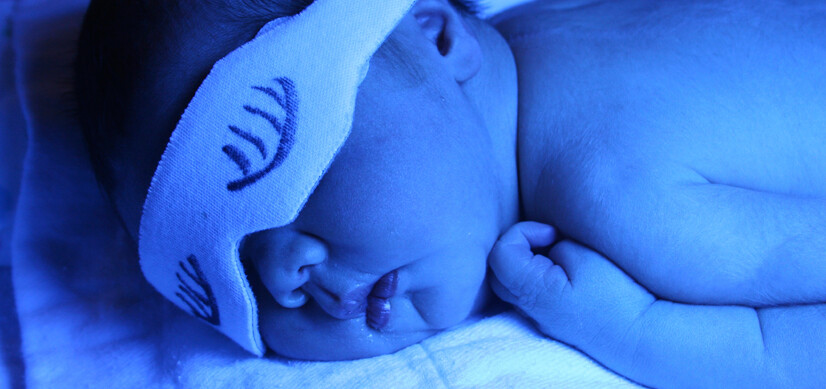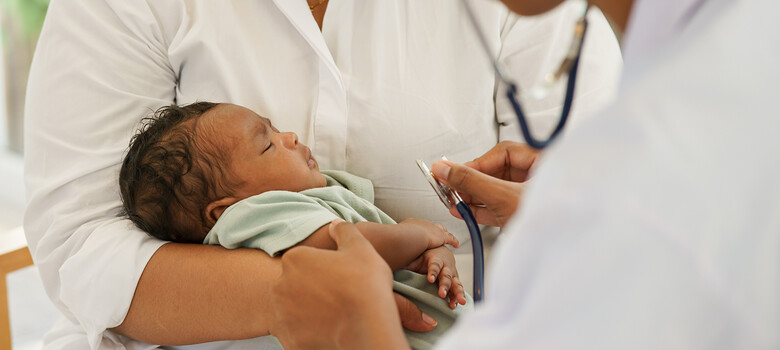 From the DukeHealth.org archives. Content may be out of date.
From the DukeHealth.org archives. Content may be out of date.
Newborn Jaundice

Newborn jaundice is extremely common. Joanne Band, MD, a pediatrician in charge of Duke University Hospital's full-term nursery, discusses jaundice -- the yellowing of the skin and eyes that can happen at birth. Jaundice is usually temporary and rarely causes significant medical problems.
Jaundice -- a yellow coloring of the skin and eyes -- occurs in approximately 60 percent of full-term newborns.
It is generally a temporary condition that does not cause babies harm and does not require any treatment. However, a few babies do require treatment -- both when they are in the newborn nursery and for a short period after they return home.
Jaundice is caused by a pigment that we all have in our blood called bilirubin. Bilirubin is released into the blood by the normal breakdown and turnover of red blood cells, which naturally occurs all the time. It is then processed by the liver into a form that can be removed in the digestive tract.
Newborns typically develop higher bilirubin levels than adults over the first few days of life because they have higher levels and faster turnover of red blood cells -- and produce more bilirubin. Their livers are also immature and less able to remove the bilirubin from their bodies. These factors lead to physiologic jaundice.
The yellow coloring of a baby with physiologic jaundice will often be noticeable around two days of life, will peak at three to five days, and will then resolve within two weeks. Physiologic jaundice poses no danger to the newborn.
Risk Factors for Pathologic Jaundice
Pathologic jaundice, however, involves a higher level of bilirubin and requires treatment to hasten the removal of bilirubin. This can occur in any newborn who has an exaggerated form of physiologic (normal) jaundice. There are also risk factors that can help guide clinicians as to which babies must be followed more carefully.
One risk factor is prematurity -- babies born more than two weeks before their due date are more likely to develop higher levels of bilirubin. The more premature a child is, the less mature their liver is at the time of birth, and the harder it is for them to start eliminating the bilirubin.
A blood type incompatibility between the mother and baby is also a reason to track the newborn’s jaundice more closely. This exists when a mother has the blood type O (and therefore has antibodies against A and B cells) and her newborn is of blood type A or B. This may cause the newborn’s red blood cells to break down more quickly due to maternal antibodies that have leaked into the baby’s bloodstream.
A blood type incompatibility also exists if the mother has a Rh (Rhesus) factor negative blood type and the newborn is Rh factor positive. This had been a common cause of severe neonatal jaundice, but is now very uncommon because Rh immune globulin (Rhogham) is given to mothers at risk before delivery.
Although breastfeeding is also considered a risk factor, it is actually lack of effective breastfeeding that is the risk factor. The likelihood of problems with nursing are minimized by nursing the newborn as soon after birth as possible and to continue nursing eight to 12 times per day for the first several days. Breast milk is an ideal food for babies, and jaundice is usually not a reason to add formula to the diet.
Other risk factors for pathologic jaundice include excessive bruising of the newborn, having a sibling that required treatment for jaundice, and being of East Asian race.
Jaundice in the first 24 hours of life is never physiologic and always merits an evaluation.
Detection
A physical exam is always important in assessing the level of jaundice. Jaundice first appears on the face, and, as the bilirubin level rises, spreads down the body. The yellow color is best appreciated in natural light, so doing the exam by a window is helpful.
Estimation of the level of jaundice by exam alone, however, is difficult and prone to errors. By obtaining blood though a prick of a newborn’s heel, an exact bilirubin level can be obtained.
The American Academy of Pediatrics guidelines dictate which newborns should be treated for jaundice. The necessity of treatment depends upon the bilirubin level, the newborn’s age in hours and the babies gestation. In general, the older the newborn, the higher the bilirubin level can be and not require treatment. For newborns with particular risk factors, such as prematurity, treatment is started at lower bilirubin levels for a given age in hours.
Complications of Extreme Jaundice
Extremely high levels of bilirubin can lead to the rare but serious condition of kernicterus, a form of brain damage. This is now a very rare condition with most cases occurring in premature or very ill babies. Treatment for jaundice starts at levels that are far lower that those that could cause kernicterus.
Jaundice Treatment
Light therapy (phototherapy) is the most common treatment for jaundice. The baby may be placed under blue light (visible light in the blue region of the spectrum) or on top of a fiber-optic blanket (“bili-blanket”) -- or both.
The blue light converts the bilirubin into a form that can be removed from the body in the urine.
Since bili-blankets are available for home use, many newborns can be treated for jaundice at home. Whether a baby is a candidate for home phototherapy depends on the level of the bilirubin and the reasons for the jaundice. Treatment generally takes several days.
Rarely, an exchange blood transfusion may be performed to treat extremely high levels of bilirubin. This is done in a neonatal intensive care unit and involves removing small amounts of the baby’s blood at a time and replacing it with fresh blood repeatedly over several hours.
Prevention
As discussed above, physiologic jaundice is not a process that can or should be prevented. The likelihood of developing pathologic jaundice, or jaundice that requires treatment, can be minimized by frequent feedings. A newborn should feed at least eight to 12 times per 24 hours.
It is essential that a newborn’s jaundice be monitored closely by a health care professional. As most healthy newborns require only a brief hospital stay, prompt follow up in the primary care physician’s office is recommended.
A doctor or nurse should see your newborn between three to five days of age as this is when the bilirubin level usually peaks. You should certainly call your child’s physician if your newborn appears more jaundiced or if he or she is especially sleepy, fussy, or feeding poorly.



